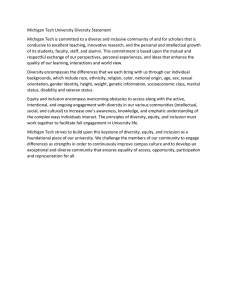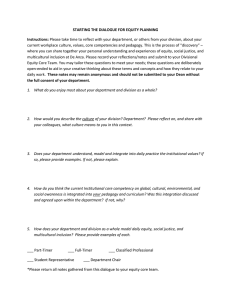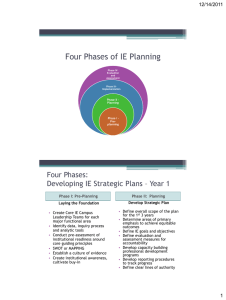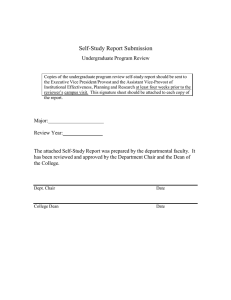Equity, Inclusion, and Diversity at Oregon State University: Defining the Path Forward
advertisement
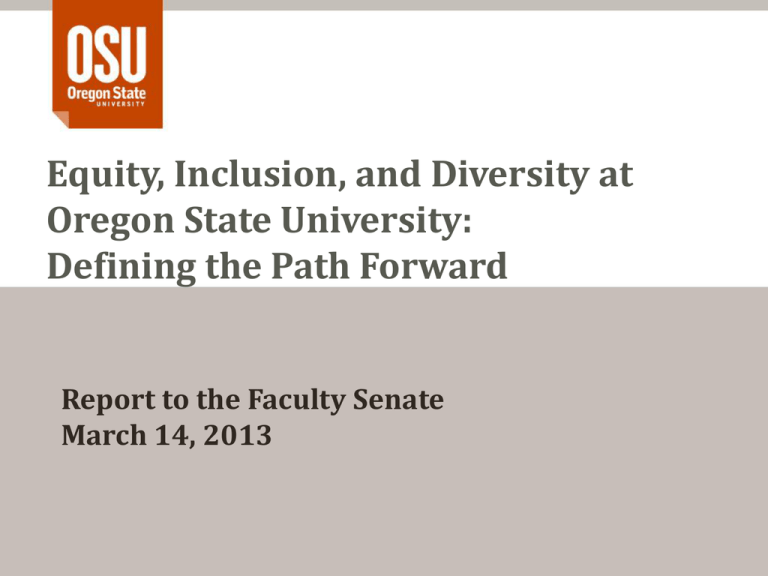
Equity, Inclusion, and Diversity at Oregon State University: Defining the Path Forward Report to the Faculty Senate March 14, 2013 Self-Study Team Members • Susan Capalbo, co-chair (Department Head, Department of Agricultural & • • • • • • • • • • 1 Resource Economics) Angelo Gomez, co-chair (Interim Executive Director of Equity and Inclusion) Brenda McComb (Dean, Graduate School) Brian Bay (Associate Professor, School of Mechanical, Industrial & Manufacturing Engineering) Elizabeth Thomas (Office Manager, Extended Campus) Janet Nishihara (Director, Educational Opportunities Program) John Edwards (Director and Associate Professor, School of Psychological Science) Larry Roper (Vice Provost, Student Affairs) M. Tonga Hopoi/Amelia Harris (ASOSU President) Michelle Bothwell (Associate Professor, School of Chemical, Biological & Environmental Engineering and Interim Director, Difference, Power and Discrimination Program) Tony Wilcox (Co-Director, School of Biological & Population Health Sciences) Self-Study Charge • • • • • • • 2 Articulate vision Broaden notion of diversity Recognize and build on successes Identify challenges and opportunities Recommend changes Articulate value of equity, inclusion, and diversity Recommend most important goals and metrics Timeline May 2011 Summer 2011: Thinking group recommends process Fall 2011: Self-study team begins self-study process Fall 2011-Winter 2012: Discussion forums are held and research of promising practices is conducted Spring-Summer 2012: Data is analyzed and report is drafted Fall 2012: External review is conducted Winter 2013: External review and self-study team final reports are completed 3 Vision I. Our Vision Oregon State University is committed through continuous improvement to be a collaborative, inclusive and caring community that strives for equity and equal opportunity in everything we do; that creates a welcoming environment and enables success for people from all walks of life; and that shares common, fundamental values grounded in justice, civility and respect while looking to our diversity as a source of enrichment and strength. II. Our Principles Inclusion: working together to create a welcoming environment through interpersonal interactions that respect and affirm the inherent dignity, value, and uniqueness of all individuals and communities. Equity: ensuring equality of opportunity in all that we do. Diversity: seeking and realizing the richness of human difference. 4 Self-Study Framework: Conceptual Framework Dimension 1 Institutional and Individual Capacity Dimension 2 Education, Scholarship, and Outreach Oregon State University “…promotes economic, social, cultural and environmental progress for the people of Oregon, the nation and the world.” 5 5 Dimension 4 University Climate and Sense of Community Dimension 3 Access and Success Self-Study and External Review Results Dimension Overarching Goal Self-Study Key Themes 1: Institutional and Individual Capacity A robust capacity to plan, implement, and evaluate comprehensive equity, inclusion, and diversity work • • • • • • Vision Commitment & accountability Comprehensive approach Engagement Individual & collective capacity Workforce diversity • • • • • • 2: Education, Scholarship, and Outreach The university’s education, scholarship, and outreach efforts incorporate equity, inclusion, and diversity content and perspectives • Curricular & co-curricular content & opportunities Collaborative & dynamic research Outreach Multicultural co-curricular experiences • 3: Access and Success Equality in access and success for people of all backgrounds and abilities and a robust ability to address the needs of diverse communities • • • • • • • Inclusion & integration Culture of support Proliferate of successful efforts Financial aid Monitoring Evaluation & promotion of innovation Assessment of differential access & impact Universal access • Prioritize student demographics and success • Build human capacity for enrollment Dialogue Linkages Sense of belonging Recognition, assessment, and improvement • Prioritize a culture of success • Develop ability for dialogue • Support and validate people doing the work • • • • 4. University A climate of inclusion, Climate and collaboration, and care that Sense of appreciates and seeks Community diversity as a source of 6 June 28, 2016 enrichment and strength, and is rooted in justice, civility, and respect 6 • • • • External Review Recommendations Prioritize faculty hiring &retention Define diversity as inclusive, but differentiated Build human capacity & leadership Align budgeting with diversity goals Ensure consistent communication Develop metrics for accountability & monitoring • Establish Chief Diversity Officer position • Establish advisory group • Ensure diversity is central to mission & a core function of leaders Develop curriculum Key Institutional Objectives for Equity, Inclusion, and Diversity Recommended by the Self-Study Team Dimension 1: Institutional and Individual Capacity • Establish Strategic Leadership Architecture • Create a senior-level advisory council • Recommend appropriate institutional leadership structures and approaches • Increase Accountability and Monitor Progress • Increase commitment and accountability • Monitor progress • Recognize and reward successful efforts • Build Human Capacity • Diversify the workforce at all levels • Focus on the professoriate 7 Key Institutional Objectives for Equity, Inclusion, and Diversity Recommended by the Self-Study Team Dimension 2: Education, Scholarship, and Outreach • Enhance Curriculum and Co-curriculum • Incorporate the principles and practices of equity, inclusion, and diversity • Strengthen and expand the Difference, Power, and Discrimination program 8 Key Institutional Objectives for Equity, Inclusion, and Diversity Recommended by the Self-Study Team Dimension 3: Access and Success • Pursue Universal Access • Pursue universally accessible physical and virtual university environments • Enhance Student Success • Monitor, improve, and equalize student academic success rates across racial and ethnic identity groups 9 Key Institutional Objectives for Equity, Inclusion, and Diversity Recommended by the Self-Study Team Dimension 4: University Climate and Sense of Community • Assess University Climate • Regularly assess the university climate • Devise strategies to realize a climate of inclusion 10 Proposed Strategic Leadership President Provost University Leadership Council for Equity, Inclusion, and Diversity Advisory to university leadership on matters related to equity, inclusion, and diversity Subcommittees Build Human Capacity Enhance Curriculum and Cocurriculum Pursue Universal Access Enhance Student Success Assess University Climate Employee Recruitment and Retention Partners Curricular and Co-curricular Partners Accessibility Partners Student Success Partners University Climate Partners 11
